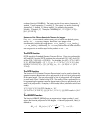
Page 5-21
The PCOEF function
Given an array containing the roots of a polynomial, the function PCOEF
generates an array containing the coefficients of the corresponding polynomial.
The coefficients correspond to decreasing order of the independent variable.
For example: PCOEF([-2,–1,0,1,1,2]) = [1. –1. –5. 5. 4. –4. 0.], which
represents the polynomial X
6
-X
5
-5X
4
+5X
3
+4X
2
-4X.
The PROOT function
Given an array containing the coefficients of a polynomial, in decreasing order,
the function PROOT provides the roots of the polynomial. Example, from
X
2
+5X-6 =0, PROOT([1, –5, 6]) = [2. 3.].
The PTAYL function
Given a polynomial P(X) and a number a, the function PTAYL is used to obtain
an expression Q(X-a) = P(X), i.e., to develop a polynomial in powers of (X- a).
This is also known as a Taylor polynomial, from which the name of the function,
Polynomial & TAYLor, follow:
For example, PTAYL(‘X^3-2*X+2’,2) = ‘X^3+6*X^2+10*X+6’.
In actuality, you should interpret this result to mean
‘(X-2) ^3+6*(X-2) ^2+10*(X-2) +6’.
Let’s check by using the substitution: ‘X = x – 2’. We recover the original
polynomial, but in terms of lower-case x rather than upper-case x.
The QUOT and REMAINDER functions
The functions QUOT and REMAINDER provide, respectively, the quotient Q(X)
and the remainder R(X), resulting from dividing two polynomials, P
1
(X) and
P
2
(X). In other words, they provide the values of Q(X) and R(X) from P
1
(X)/P
2
(X)
= Q(X) + R(X)/P
2
(X). For example,
QUOT(X^3-2*X+2, X-1) = X^2+X-1
REMAINDER(X^3-2*X+2, X-1) = 1.
Thus, we can write: (X
3
-2X+2)/(X-1) = X
2
+X-1 + 1/(X-1).


















